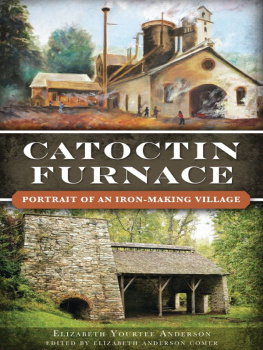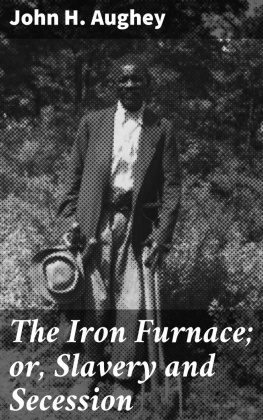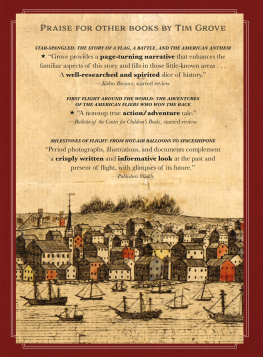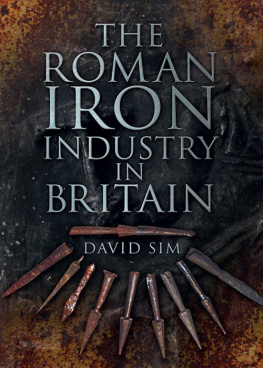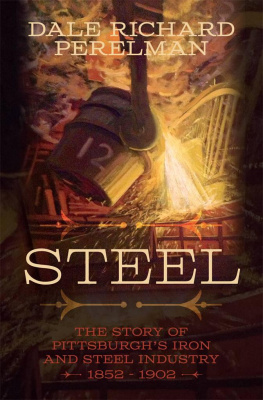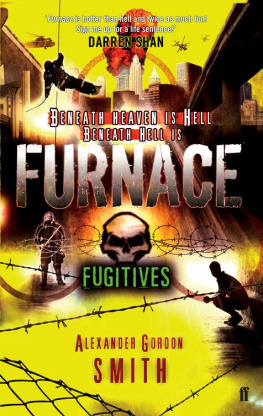

Mid- to late nineteenth-century appearance of the Catoctin Furnace village, with detail of Auburn Farm. Created by Tanya Catignania.

Published by The History Press
Charleston, SC 29403
www.historypress.net
Copyright 2013 by Elizabeth Y. Anderson
All rights reserved
Front cover, top: Deborah Furnace in Blast by Claudette Pridemore, 1975, oil on canvas.
Bottom: Photograph of Isabella stack and casting shed, Catoctin Furnace, by Cam Miller, 2012.
First published 2013
e-book edition 2013
Manufactured in the United States
ISBN 978.1.62584.071.4
Library of Congress CIP data applied for.
print edition ISBN 978.1.62619.001.6
Notice: The information in this book is true and complete to the best of our knowledge. It is offered without guarantee on the part of the author or The History Press. The author and The History Press disclaim all liability in connection with the use of this book.
All rights reserved. No part of this book may be reproduced or transmitted in any form whatsoever without prior written permission from the publisher except in the case of brief quotations embodied in critical articles and reviews.
CONTENTS
PREFACE
EDITORS NOTE: Researching and writing Catoctin Furnace: Portrait of an Iron-Making Village was a true labor of love for my mother. As a social historian, her goal was to produce a collective biography of the furnace workers and to give them a voice so their lifework and contribution to the success of industry in the United States would not be overlooked. Her painstaking research continued until her death in 2011, and it was her dream to see this book in print. In the original manuscript, she ended the story when the furnace shut down for the final time. She and I talked about adding a chapter that covered the preservation movement in the twentieth century, and this has been done. I have had the help of family and friends: I am indebted to Margaret and Jacob Comer for reading and editing the manuscript, to Anne Comer for helping interpret village life, to Joel Anderson for contributing the chapter on the mechanics of the furnace, to Robert Wanner and Tery Harris for help with the manuscript and to Chris Gardiner and Laura Gardiner for help with images. Finally, a thank you goes to the members of the Catoctin Furnace Historical Society, Inc., who keep the spirit and heritage of Catoctin Furnace alive. What follows is my mothers original preface to this work.
My fascination with Catoctin Furnace reaches back to a memory of well-proportioned, neatly whitewashed houses clustered along the road between Frederick and Thurmont, Maryland. I had heard stories of the involvement of Marylands first governor, Thomas Johnson, with the old iron furnace. An air of romance surrounded the place. The frantic hustle and din of the past were quiet, and the ironmasters mansion seemed to sleep in the serenity. Years later, when I returned to the Thurmont area and began to attend Harriet Chapel, my curiosity about the history of Catoctin Furnace was reawakened. I was delighted to be able to buy one of the workers cottages and, along with my family, plan and execute its restoration.
When the opportunity arose to work on an honors paper, I was encouraged to choose Catoctin Furnace as the subject. My first reaction was that most of the information had already been uncovered. The furnace was mentioned in historical accounts such as Scharfs History of Western Maryland and Williamss History of Frederick County. Also, a number of archaeological investigations had taken place in the area, each of which had included historical research. My fears about a lack of information were completely unfounded. There was a wealth of undiscovered material on Catoctin Furnace. I have spent eight months in research and realize that there are records and stories I have not uncovered. The search will go on.
The people who have helped me in my research are too numerous to mention. I particularly want to thank Marie Burns, who gently helped me find my way through a tangle of land transfers; Clement and Harriet Gardiner, who put up with my presence for days as I read hundreds of pages of letters and ledgers; Joanne Miller, who made copies; members of the Catoctin Furnace Historical Society Eugene Anderson, Mary Rae Cantwell and William Renner; members of the Anders, Carbaugh, Fraley, Hoke, Martin, Miller, Penwell, Reed, Stitely and Sweeney families of the Catoctin Furnace area; the priest and people of Catoctin Episcopal Parish, whose interest and encouragement meant so much; the staff of C. Burr Artz Library; the Washington County library staff; Moravian Archives personnel, including my translator, Robert Steelman; the Episcopal Diocese of Marylands Garner Ranney, archivist; Kay Harbaugh and Judith Ricketts of the Board of Education of Frederick County; and Tanya Catignani, for producing the site map. John McGrain provided valuable editing and additional Catoctin Furnace references from his extensive files.
Everywhere I went I was treated most courteously. The staffs of the Library of Congress, National Archives, Maryland Hall of Records, Eleutherian Mills Historical Library, Maryland Historical Society and Frederick County Courthouse were very helpful. I feel that the material I have gathered has been the result of a joint effort. I could not have done it alone. I especially want to thank Dr. Leonard Latkovski and Dr. Gerald McKnight, advisors, whose guidance and patience are deeply appreciated.
This research could never have been accomplished if it had not been for the support of my familyespecially Elizabeth Anderson Comer, for her companionship, help and advice, and Joel Anderson, for his help and interest as official photographer and for his patience. I have been researching and writing of the past, but I want to dedicate my work to the future, so that the story may live for the younger generation as it has come to life for me. In that spirit, I dedicate this book to Margaret, Jacob, Anne, Kate, Kelby, Chaslyn, Caleb, Jeffrey, Derek, Adrienne and Lilienne.
Chapter 1
THE EARLY YEARS
Thomas Johnson and his brother James located their iron furnace in an area that had shown earlier promise as an industrial site. The builders found all the necessary elements for a successful operation on the eastern slope of Catoctin Mountain in northern Frederick County, Maryland. Their choice proved to be a wise one, for Catoctin Furnace would operate for over a century. Not only were they establishing a business, but the Johnsons were also deeply involved in the American Revolution.
Pioneers came to the central lands of provincial Maryland for a number of reasons. Some hoped to settle and operate small businesses. Others were speculators, like the Johnsons, bent on development and industrialization. Some followed trails leading from Pennsylvania settlements to new lands farther south. Others pushed west from Marylands Tidewater.
Early arrivals to the area were attracted not only by the rich land but also by clear rushing streams and a plentiful supply of timber. Abundant water, needed by the settlers for crops and livestock, was also a source of power. Logs, used for building and shaped into tools and furniture, were also a vital source of fuel.
Under the provisions of the Charter of Maryland, the Lord Proprietary owned all the land in the province, with power to grant any part of it to someone willing to pay an annual rent. In March 1732, Lord Baltimore, hoping to attract German settlers from Pennsylvania, offered a tract to any person who would settle on the back land of the province. One of the earliest settlers to take advantage of this offer was John Vertrees (Verdies), who received a patent on December 13, 1738, for 128 acres, which he named Johns Mountain.
Next page
